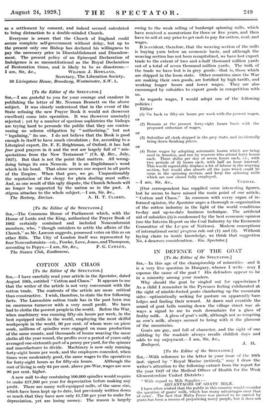COTTON AND CHAOS
[To the Editor of the SPECTATOR.] Sift,—I have carefully read your article in the Spectator, dated August 10th, entitled "Cotton and Chaos." It appears to me that the writer of the article is not very conversant with the cotton trade. The contents of the article are more critical than constructive. I wish, therefore, to state the few following facts. The Lancashire cotton trade has in the past been run on enormous turnover with a very small profit. We have had to clothe the poorest people in the world. Before the War, when machinery was running fifty-six hours per week, in the best equipped mills in the world, employing the most skilful workpeople in the world, 90 per cent. of whom were on piece work, millions of spindles were engaged on mass production of the same counts, and thousands of looms weaving the same cloths all the year round, the profits over a period of years only averaged one-sixteenth part of a penny per yard, for the spinner and manufacturer to divide. Machinery is now only running forty-eight hours per week, and the employers conceded, when times were moderately good, the same wages to the operatives for forty-eight hours as for fifty-six hours. Although the cost of living is only 64 per cent. above pre-War, wages are now 90 per cent. higher.
A new mill to-day containing 100,000 spindles would require to make 2.17,500 per year for depreciation before making any profit. There are many well-equipped mills, of the same size, which have been kept up to date, but previously written down so much that they have now only 11,750 per year to make for depreciation, yet are losing money. The reason is largely
owing to the weak selling of bankrupt spinning mills, which have received a moratorium for three or five years, and then have to sell at any price to get cash to pay for cotton, coal, and wages.
It is evident, therefore, that the weaving section of the mills is buying yarn below an economic basis, and although the weaving section has not been recapitalized, we have lost export trade to the extent of two and a-half thousand million yards out of a total of seven thousand million yards. The bulk of the trade we have lost is in grey goods—that is, those which are shipped in the loom state. Other countries since the War are making their own goods, are fortified by high tariffs, and working longer hours and lower wages. They are also encouraged by subsidies to export goods in competition with us.
As regards wages, I would adopt one of the following policies : Either
(1) Go back to fifty-six hours per week with the present wages,
or
(2) Remain at the present forty-eight hours basis with the proposed reduction of wages,
or
(3) Subsidize all cloth shipped in the grey state, and incidentally bring down finishing prices.
or
(4) Raise wages by adopting automatic looms which are being used in America, and run by weavers who attend forty looms each. Three shifts per day of seven hours each, i.e., with two periods of 34 hours each, with half an hour interval. This would regrettably displace a lot of labour in the weaving section, but would also absorb all the yarn which could be spun in the spinning section, and keep the spinning mills which are now closed fully employed.
[Our correspondent has supplied sonic interesting figures, but he seems to have missed the main point of our article, "Cotton and Chaos." In common with every organ of in- formed opinion, the Spectator urges a thorough re-organization of the cotton industry in the light of the world conditions to-day and up-to-date business technique. The artificial aid of subsidies (3) is condemned by the best economic opinion (see the Interim Report on the Coal Industry by the Economic Committee of the Le-gue of Nations). Modern conceptions of international socia: progress rule out (1) and (2). Without laying claim to inside knowledge, we think that suggestion No. 4 deserves consideration.—En. Spectator.]






























 Previous page
Previous page